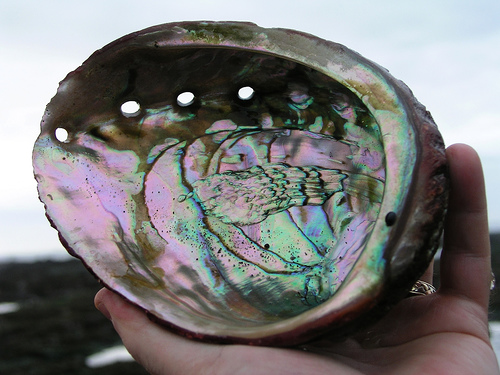Photo: Flickr/artolog
Perhaps you’ve seen lovely, iridescent jewelry made from abalone shells, or tried a piece of this delicately textured meat at an Asian restaurant, but by and large, most people are not too familiar with abalone. A shame too, as abalone is one of the most versatile and uniquely flavored seafoods out there, with a fascinating history to boot. (By the way, it’s pronounced ab-uh-lo-ney, where the “e” is not silent.)
Abalone is the name for a broad category of gastropod mollusks, with a flattened shell that is lined with mother-of-pearl on the inside. A series of holes near the edge of the shell is used for water exchange and excretion of waste products. The bulk of the animal—what we eat—is a muscular foot, known for clinging tightly to rocks or whatever ledge the abalone is perched on. When the abalone feels threatened, it essentially turns into a large suction cup, making it almost impossible to dislodge. On the other hand, if flipped over, the abalone is totally vulnerable.
The abalone industry has its roots in immigrant ingenuity. Back in the 18th and 19th centuries, fur traders were actively trapping sea otters, the abalone’s primary predator, which enabled abalones to flourish in ocean beds two and three deep. Then the Gold Rush began. Thousands of Chinese, attracted by the lure of mineral riches, journeyed to the West Coast. There, they discovered that the dense, intertidal beds of abalones were oceanic gold, and they began vigorously harvesting abalones. When ordinances were passed prohibiting abalone harvests in waters less than 20 feet deep, enterprising Japanese divers moved to deeper waters for their catch, using old wine barrels as floats to rest between dives. These fishermen were known as “sake barrel divers” for their unusual technique. By 1929, abalone had become a more mainstream food, and the first commercial fisheries were established to meet domestic demand.
In the United States, there are eight species of abalone: red, green, black, white, pink, pinto, threaded and flat. They range from Alaska to the southern tip of California, but immense commercial pressure and pollution from coastal cities have wiped out the once teeming abalone beds. Today, there are abalone farms that ensure a steady supply of abalone, as the world’s wild stocks are depleted and illegally poached. However, the abalone’s slow growth and reproductive cycle, combined with insatiable demand, mean that prices will be high for the foreseeable future.
Demand for abalone reaches fever pitch around this time of the year, since festivities are in full swing for Lunar New Year. In addition to abalone’s vaunted status as a luxury item, it is a homophone in Chinese for “assured surplus,” so it is considered a particularly auspicious food to eat.
Be careful that you purchase your abalone from a reputable source and carefully read all labels, as there are many versions of imitation abalone out there! Top shell is commonly used as an abalone substitute. It comes from another mollusk family with cone-shaped, spiral shells. While the flavor of top shell is similar to that of abalone, the texture is very different. So if you notice one can of “top shell abalone” selling for $5, and another can selling for 10x more, you’ll know why.
At Element Seafood, we carry farmed blue abalone, grown in the clear, sapphire waters of Bream Bay, north of New Zealand. A steady diet of seaweed and plankton gives the abalone a firm, pearly white meat with subtle flavor. This blue abalone is great when prepared raw as sashimi, giving a crunchy sweetness and distinctive clam-like finish in every bite. When lightly poached, steamed or sautéed, the abalone develops a creamy clam flavor. To try some for yourself, give our sales department a call.
